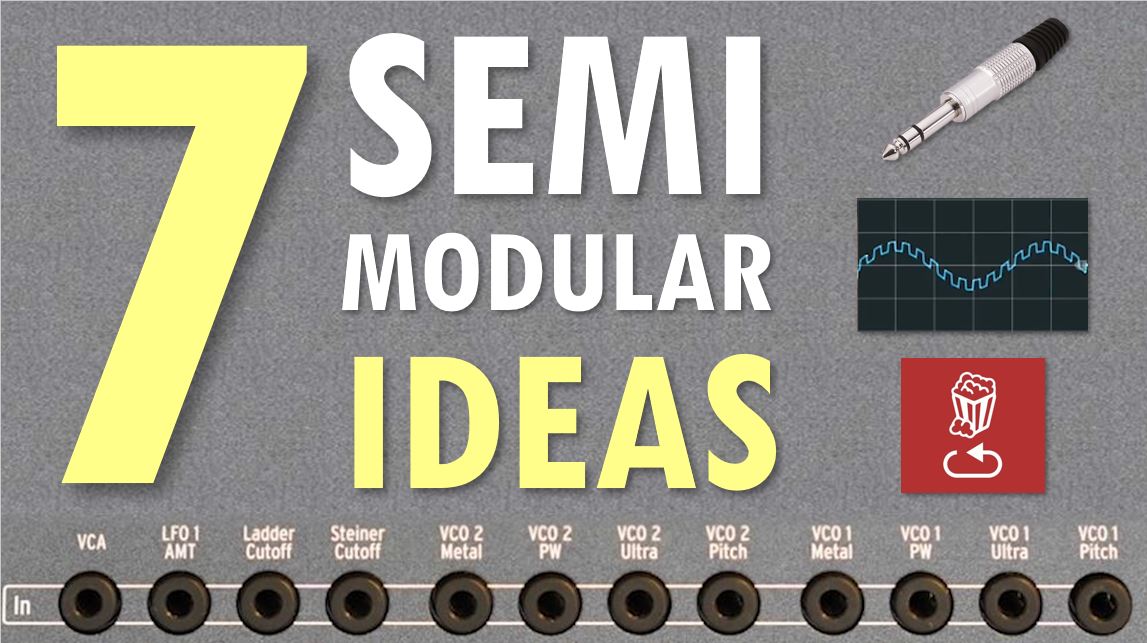In this clip I’ll look at a few ideas to take your semi-modular synth to the next level with Eurorack modules. In particular, I focus on a few that might make a big difference in what you can do with your semi-modular synth. Most semi-modulars come with “synth basics” such as oscillators, envelopes, lfos, filters and a sequencer. This clip looks at ways to extend these basic capabilities by patching internally and using external modular gear.
There are plenty of great semi-modular synths – Mother-32, MiniBrute 2 and 2S and many others. I’ll be using the MatrixBrute in this video, though most of the tips are applicable to other synths.
TIP #1: Safely connecting CV to the Expression inputs of synths and guitar pedals using a floating ring cable.
If your synth (or effects pedal) has an expression input, that might be a nice way to create modulations with voltage that might otherwise not be possible. Proceed with caution and follow the instructions in the video carefully.
TIP #2: Using external envelopes to vary your synth sounds
Synth envelope slopes are typically fixed, though they can have a significant impact on your sound. In the clip I demonstrate how to swap a synth’s internal logarithmic slope with an external one, for a dramatic difference in the character of a sound’s VCA attack slope.
TIP #3: Using MIDI to CV for sound layering and external control
In a world where most semi modular synths are subtractive synths and occasionally a touch of fm, it’s nice to be able to bring in other types of synthesis like physical modeling, additive, and wave table synthesis. These sounds can either be played independently or layered along with more “traditional” synth sounds. Passing external sounds through your semi-modular synth lets you apply its internal modulations, filters and effects to it.
TIP #4: Modular sequencing
Generally speaking, semi modular synths have relatively simple sequencers. Ranging up to 64 steps – sequencers are typically set in stone once programmed. The Modular world on the other hand has a variety of different interesting sequencers such as Euclidian sequencers and the Turing machine style sequencers in Disting or Ornament and Crime. These let you either sequence your synth entirely externally or combine your internal sequencer and the external one. If you have more than one oscillator in your semi modular synth, you can also play paraphonically or polyphonically depending on your gear.
You can also use a modular clock divider like maths timed to the gate or sync outputs to create events that in sync with but not necessarily directly in the same timing as your sequence. Check out my Maths tutorials for more information about that.
Tip #5: Extending your sequencer with internal patching
While we’re on the topic of sequencing, a semi modular synth can be re-routed internally, not just with external modules. One of the cool ways to rewire a semimodular synth is to mess around with its sequencer. On the DFAM for example, you can generate triggers or move the clock forward regardless of whatever the current sequencer tempo is. In this clip I show how to add ratchets to the MatrixBrute sequencer, something it doesn’t support out of the box.
TIP #6: Combining multiple mod sources
When you think of modulation sources, you might think of one envelope or one LFO modulating something. But you can mix multiple modulation sources to create one overall “crazy” mod source. On the Mother-32 you can do that using the mixer section. On the MiniBrute 2 – you have mixer and VCA combo jacks, and on the MatrixBrute you can combine up to 16 modulation sources into one destination, which is pretty wild.
TIP #7: Adding external modular effects
Adding external effects to your sound is a pretty straightforward, but I think worth mentioning as a great way to expand your semi modular synth. Whether it’s Reverb, Delays or Granular synthesis – effects modules can greatly enhance and expand the sound of your synth.
